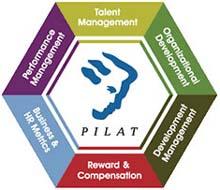iSolon offer a proven range of tried and tested assessment and profiling tools. Most can be completed on-line. But we always recommend that the individuals who complete them are able to speak with either the author of the resultant report or a qualified and experienced coach who can interpret it.
- Myers-Briggs Type Indicator [MBTI]
- 360°
- The Leadership Dimensions Questionnaire [LDQ]
- The Belbin Team Roles Self-Perception Inventory
- The Kirton Adaption-Innovation Inventory [KAI]
1. Myers-Briggs Type Indicator or MBTI
This simple, low cost, on-line questionnaire reveals the subject’s personality type, expressed as a code with four letters. Answering the questions reveals their preference in each of the following four categories:
Favourite world: Do they prefer to focus on the outer world or on their own inner world? This is called Extraversion (E) or Introversion (I).
Information: Do they prefer to focus on the basic information they take in or do they prefer to interpret and add meaning? This is called Sensing (S) or Intuition (N).
Decisions: When making decisions, do they prefer to first look at logic and consistency or first look at the people and special circumstances? This is called Thinking (T) or Feeling (F).
Structure: In dealing with the outside world, do they prefer to get things decided or do they prefer to stay open to new information and options? This is called Judging (J) or Perceiving (P).
The report will show by how much the subject prefers one dimension to another. For instance, they may be extremely I or extremely E, or sit almost in the middle between the two. There are no right or wrong answers.
We recommend that the subject considers sharing their profile with their colleagues, perhaps during a team meeting. The benefit is not generally with the individual, the vast majority accepting the validity of their profile, but rather through knowing the MBTI of their colleagues. It should help the individuals on the team to a better understanding of their colleagues.
2. 360°
Our experience is mainly with Pilat, with whom we have developed an excellent relationship over the years. This means that they will personalise the appearance of the survey with your company’s logo and modify the questions to suit your organisation’s challenges precisely.
Typically the subject would complete the questionnaire themselves and ask their staff, their peer group colleagues and their boss to complete the same questionnaire on them in confidence. The subject will then receive a report which compares and contrasts their answers with those of the other groups. Hence, the all-round or 360° view.
We recommend that when moving to a new role, subjects should consider completing another 360° after a year or so, and roughly every year or two thereafter. A 360 four years old, and completed with a different team will be of little value to them.
3. The Leadership Dimensions Questionnaire [LDQ]
The premise of this tool is that overall leadership styles needs to be matched to the context in which leaders are working. It is the ‘fit’ between the style of the leader and the context that determines both leadership effectiveness and follower commitment.
The LDQ has the advantages of:
- Identifying the style of the respondent
- Identifying the context in which the leader works
- Establishing the match between style and context
- Establishing current performance
- Establishing current follower commitment
All users are provided with a comprehensive report that covers:
- Individual profile of respondent
- Context positioning
- Match of profile to context
- Indication of development needs
- Thoughts for the formulation of development actions
A unique feature of the LDQ is its ability to relate profiles of the scores across the following 15 dimensions to three different leadership styles and their relevance to the degree of organisational volatility.
Elements of the Leadership Dimensions Questionnaire
Intellectual dimensions (IQ)
- Critical Analysis and Judgement
- Vision and Imagination
- Strategic Perspective
Managerial dimensions (MQ)
- Resource Management
- Engaging Communication
- Empowering
- Developing
- Achieving
Emotional and social dimensions (EQ)
- Self-awareness
- Emotional resilience
- Intuitiveness
- Interpersonal sensitivity
- Influence
- Motivation
- Conscientiousness
The LDQ has been used extensively in the UK, the US and Europe for commercial organisations, government departments and Armed Forces.
4. Belbin Team Role Types
The Belbin Team Roles Self-Perception Inventory will help the subject to identify their natural and preferred contribution to team efforts and where they may tend to rely more on the contribution of their colleagues.
Through this exercise, people can understand better the key differences between themselves and other team members. They will identify where they make their biggest contribution and where they depend upon the skills of others.
Meredith Belbin describes what he terms as an ‘allowable weakness’. This can be considered as the price to pay for getting the contribution of each individual. And it is particularly relevant within a team environment as everyone will have an ‘allowable weakness’. Here is an example:
| Belbin Team Role Type | Contribution | Allowable Weakness |
| Completer/Finisher | Painstaking. Delivers on time. Conscientious | Inclined to worry unduly. Reluctant to delegate |
The full list of Belbin Team Role Types is as follows:
- Implementer
- Completer/Finisher
- Shaper
- Co-ordinator
- Resource Investigator
- Team Worker
- Plant
- Monitor/Evaluator
- Specialist
The Belbin Team Roles Self-Perception Inventory can be completed on-line for minimal cost.
5. The Kirton Adaption-Innovation Inventory [KAI]
KAI is one of the world’s foremost measures for problem-solving, teamwork and creativity.
KAI measures style of problem solving and creativity. KAI is used:
- in the training of managers and key teams as part of the management of change
- in group training and individual development as part of the management of diversity
- for the enhancement of group cohesion and effectiveness
- for leadership techniques, and
- for problem-solving team building.
KAI is also widely used by academics in the fields of business, psychology, sociology and education.




